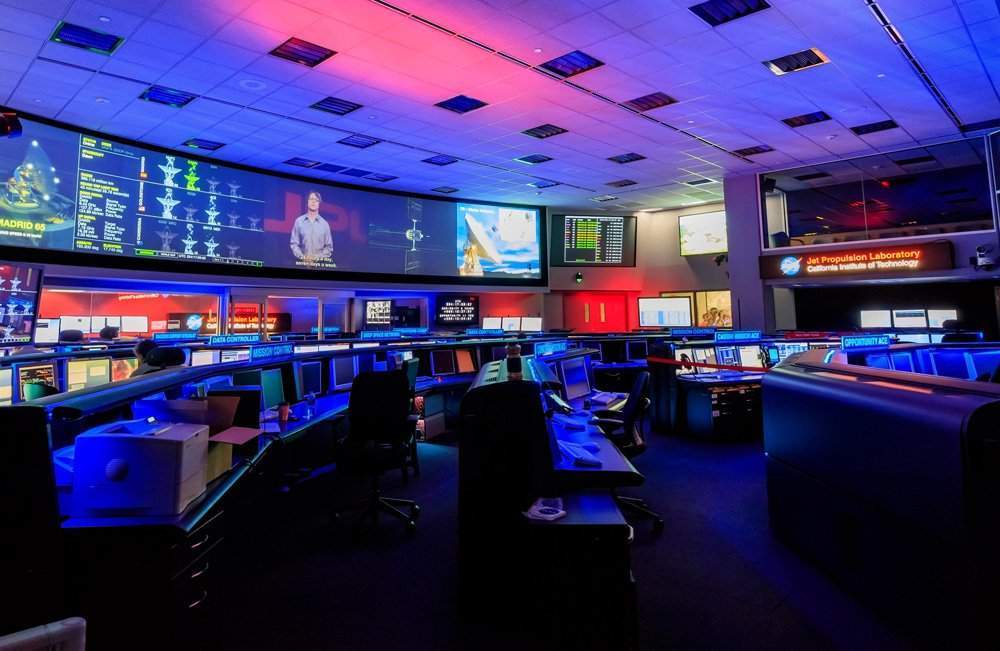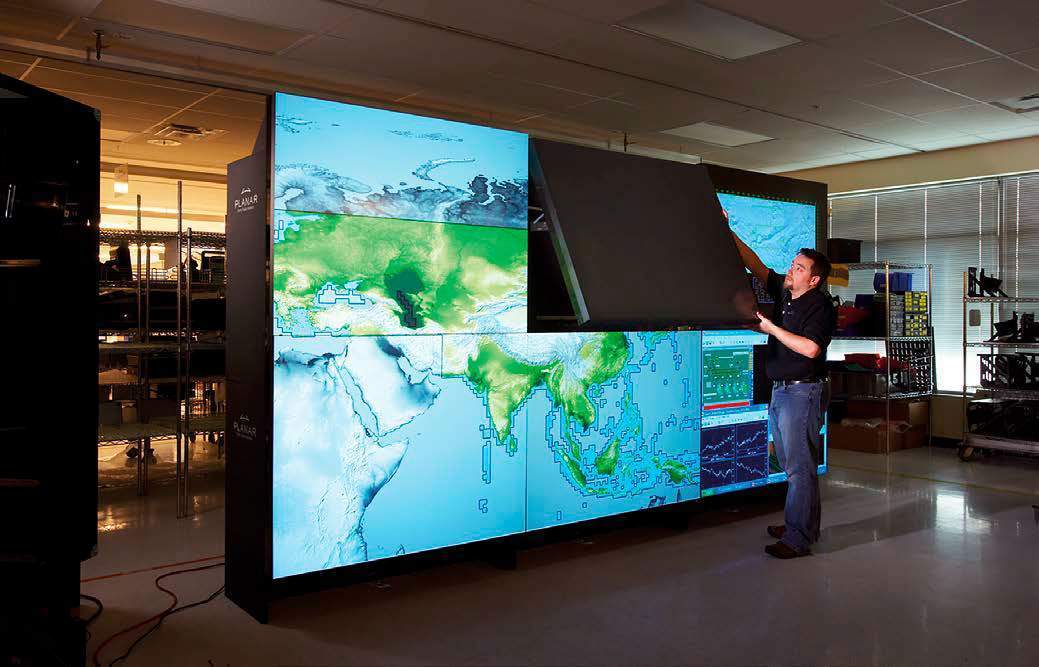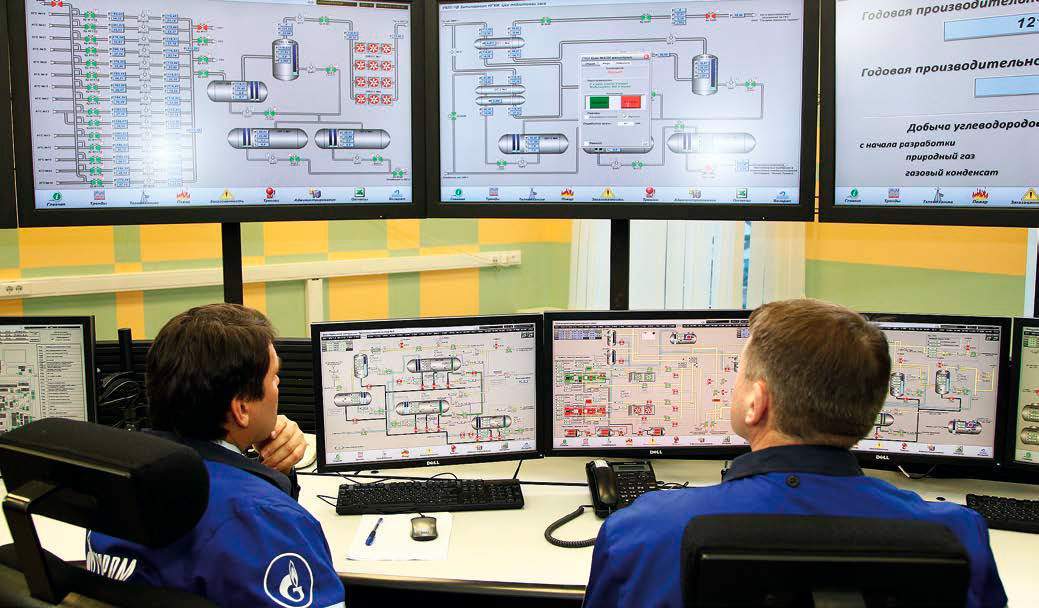
VIDEO WALL DISPLAY
A video wall display is a large screen that combines a number of visualization devices in order to demonstrate graphic and video information obtained from various sources in a multi-window mode. Video walls are designed for round-the-clock operation for a long time (24/7/365).
To date, there are three technologies for building video walls: video cubes, professional liquid crystal panels, and light-emitting diode (LED) modules. Each of the technologies has its own characteristics that must be taken into account in order to create an information display system in the control room.
Information video wall display systems based on video cubes
Creating video walls based on projection video cubes is the oldest and most proven way to build a system for displaying information for collective use. The video cube is a rear projection system: a screen, a projector, and a system of mirrors in a single housing. In modern projectors, LEDs have replaced lamp light sources, and video cubes are called “LED video cubes”, which introduces some confusion in the terminology (since there are light-emitting diode (LED) modules along with LED video cubes). A split screen created from video cubes is almost seamless, making the image look coherent and inseparable.
Technology development trends have led to the emergence of new models of video cubes, in which, instead of gas discharge lamps, fail-safe, super-bright LEDs of red, blue, and green colors serve as a light source. An important advantage of LED light sources is their long service life. LED video cubes to provide the control room with the picture quality, optimized color reproduction, fine-tuning of the video image, and minimal maintenance.
The use of special design solutions (LED light sources with a service life of 100 thousand hours, air filtration systems, multi-channel input modules, etc.) makes it possible to achieve continuous operation of video walls based on video cubes for at least 11 years.
The most important advantage of video walls based on video cubes is the creation of an almost seamless split screen with high information capacity for a reasonable price.
Advantages of video wall display based on video cubes:
- Brightness: balanced, specially selected for the comfortable perception of information during a long time of the dispatcher shift.
- The gap between the screens is minimal: from 0.1 mm for rear access and from 0.7 mm for full front access.
- A wide range of cube sizes to build the screen size you need.
- Ease of access to all electronic components of the projection module provides a quick recovery module.
- The service life of light sources is 100,000 hours (up to 50% reduction in maximum brightness).
- Frontal access simplifies the maintenance of the split screen and reduces the requirements for the size of the technological room.
Disadvantages of video wall display based on video cubes:
- Rather narrow viewing angles of the screen (±37° horizontally and ±32° vertically), which affects the placement of operators in the control room.
- Special requirements for temperature conditions in the room: it is necessary to install an air conditioning system with the ability to maintain a certain temperature (23 ± 3 °).
- The large installation depth of the rear access cube requires a large technology space behind the screen.
- High cost – higher than LCD displays.
- High requirements for the qualifications of engineers who carry out installation and maintenance.

Information video wall display systems based on professional LCD displays
Recently, SDIs based on professional (designed to work in 24/7 mode) liquid crystal displays have been increasingly used. They are easier to maintain and offer a more compact solution than video cube video walls.
A separate place among LCD displays is occupied by the Planar Matrix G3 ultra-thin professional video wall solution with remote electronics and redundant power supplies, created by Planar Systems, a leader in the production of equipment for SOI. The removal of computing power and power supplies at a considerable distance from the screen (up to 150 m) provides absolute noiselessness, lower heat generation (about 20% less compared to analogs), and ease of installation and maintenance. Remote modules, located in a separate technological room outside the control room, can be repaired without interfering with the work of the duty shift. The special temperature regime of the server room improves the reliability of electronic components.
Benefits of Planar Matrix G3:
- Noiseless operation of LCD panels.
- Significantly reduced heat dissipation compared to other LCD panels.
- Ultra-thin solution: depth including mounting is only 9 cm.
- Redundant power supply to increase the fault tolerance of the video wall.
- Perfectly flat screen by precisely adjusting the position of each LCD in six axes.
- Frontal access to any panel without the need to remove it from the mount ensures ease of maintenance.
- Service maintenance does not interfere with the work of the dispatcher shift.
Advantages of information video wall display systems based on professional LCD displays
- Brightness balanced for indoor use.
- A high resolution.
- The wide viewing angle (178°) reduces the requirements for workplaces in the control room.
- Shallow installation depth of LCD modules together with fixtures in small spaces.
- No special requirements for temperature conditions in the room.
- Does not require the creation of technological space behind the screen.
- Ease of installation.
- Low cost and low operating costs.
Disadvantages of information video wall display systems based on professional LCD displays
- Large screen gap (usually from 3.5 mm).
- A small selection of professional LCD sizes with the smallest possible screen gap.
- The life of the backlight system is half that of other solutions – 50 thousand hours (up to 50% reduction in maximum brightness values).
- Lack of redundant power supply.
- Lack of access to all electronic components of the LCD in the event of a breakdown requires the entire module to be sent to a service center.

Information video wall display systems based on light-emitting diode (led) modules
Relatively recently, the first SOI based on light-emitting diode (LED) modules began to be installed in control rooms. This new technology is just beginning to take over the market, but today there are a number of advantages and disadvantages that serve as arguments for and against its use in control centers.
Miniaturization in the field of surface mount LED (SMD) manufacturing has led to a reduction in the distance between the LEDs and the creation of modules with high resolution, which has led to such solutions being used in control rooms. Thin screen gaps are imperceptible even from a close distance, making the screen look completely seamless, and the displayed image is coherent. The small size of the LED modules allows you to build a split screen exactly according to the specified size. The comfortable viewing area of the video wall is large enough due to wide viewing angles (up to 160°). Accordingly, there will be fewer restrictions on the placement of jobs in the control room.
Manufacturers guarantee that LEDs built on LED modules will last for a long time: about 11 years before a 50% decrease in maximum brightness. In fact, the service life can be doubled: the brightness of the LED panels is excessive for the control room, so they can be operated not at maximum brightness, but at a halved one. LED modules have a low noise level and heat up rather weakly, so there is no need to install a special air conditioning system in the control room.
Bright advantages of modern LED modules are balanced by relatively low (compared to other LCD panels and video cubes) resolution. Therefore, for example, the use of a control room LED video wall will require a serious adaptation of the displayed scheme from SCADA. In addition, at present, LED split screens are several times more expensive than similar video cubes and professional LCD panels.
Significantly different from all video walls based on LED modules is another solution from Planar Systems – DirectLight ™. As in the Planar Matrix G2, the power supply can be placed in the server room at a distance of up to 60 m from the video wall. This provides several significant advantages at once:
- noiselessness of work;
- significant reduction in heat generation compared to similar solutions;
- ultra-thin solution: depth with fastening is only 102 mm;
- redundant power supply to increase the fault tolerance of the video wall;
- perfectly flat surface due to precise adjustment of the position of each LED module along different axes (left-right, up-down and front-rear adjustment at eight points of the module);
- frontal access for the convenience of service of any module;
- there is no need to create a technological room.
We have only talked about the main points that need to be considered when creating new video walls. In practice, in each specific project, we, as a system integrator, have to work out a huge number of technical characteristics and various factors that affect the choice of a specific solution, manufacturer and model of equipment – room features, possible scenarios for working with information, compatibility with other equipment of the control room, project budget and much more.
A competent approach to the task and a wide selection of devices and technologies presented today in the information display systems market allow us to design and implement the optimal solution for each of our customers.
